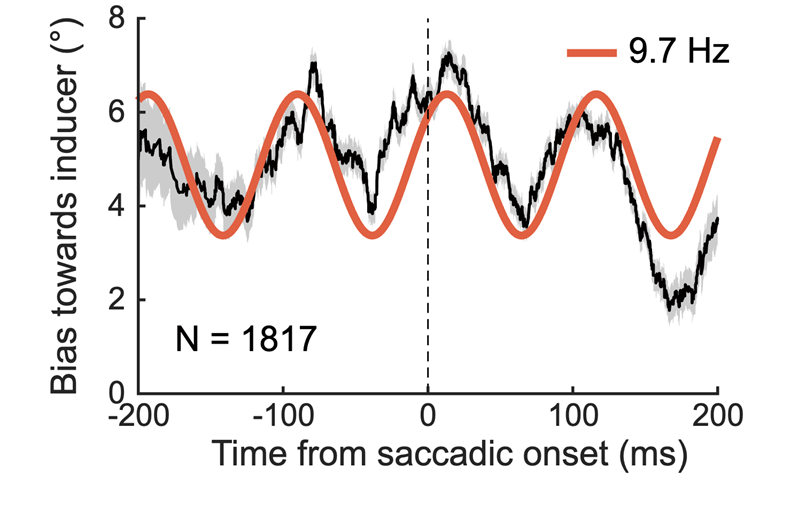The role of alpha oscillations in keeping the world stable as we move our eyes
Published in Neuroscience
The world appears stable and continuous, despite the discontinuous input from the retina, brief “snapshots” interspersed with fast saccadic eye-movements. Here we show that alpha-oscillations are fundamental in integration of pre- and post-saccadic signals.
As we view the world, it appears stable and continuous: yet this impression is built from very unstable input gleaned from our senses: a series of “snapshots”, brief fixations interspersed with fast saccadic eye-movements. The perception of a stable world relies at least in part on integration of signals between fixations: but how does the system know what information should be integrated, and extract them from all the signals continuously present in the brain?
Integration across saccades
One way to study integration across saccades is to measure how the previous, pre-saccadic stimuli bias the perception of the currently viewed stimuli. Along these lines, we measured orientation judgments for briefly presented stimuli, as participants made horizontal or vertical saccades. The judgments were consistently biased towards the orientation of the previous pre-saccadic stimulus, suggesting integration of the two stimuli.
Perceptual Oscillations
The bias, however, was not constant, but waxed and waned at alpha frequencies (around 10 Hz), in synchrony with the saccadic eye-movements. The oscillation was strong and highly significant, with amplitude about half that of the mean biasing effect. The black curve in the figure shows the average bias in observer judgments, as a function of time before or after the onset of the saccade (zero in the graph). Bias clearly oscillates over time, both before and after the onset of the saccade. The red curve shows the best fitting sinusoid, which had a frequency of 9.7 Hz.

Several factors bias perception, all well explained within the Bayesian concept of priors or expectations. One prevailing bias in all perceptual judgements is termed central tendency or regression to the mean, where judgments tend to be biases towards the mean of all stimuli displayed recently. Central tendency was strong in our study too. However, although all orientation judgments were systematically biased towards the mean, the bias was constant, with no measurable oscillations at alpha, or any other, frequencies.
The role of alpha oscillations
Perceptual oscillations occur in the bias towards the orientation of previous stimuli, but not in the bias towards the mean, suggesting that alpha rhythms may be selectively instrumental in communicating short-term perceptual information across saccades, helping to preserve continuity and stability. Biases towards long-term perceptual priors, such as the mean, do not show this oscillation, suggesting that short- and long-term perceptual memory are mediated by distinct neuronal circuitry.
Exactly what role the oscillations play in the communication of information still requires further research. Most researchers agree that oscillations play a role in “binding” the various forms of sensory information, and in particular binding sensory with motor signals. Saccadic eye movements are a fundamental part of active, explorative vision, and clearly need to be synchronized. However, given the lengthy and variable delays both in visual processes and in the generation of saccades, keeping the two in synch is by no means automatic. The fact that the modulations in orientation judgments are synchronized to the onset of saccadic eye-movements suggests that one role they may serve is to bind the visual and motor information, with high temporal precision, while communicating information about recent perceptual history.
Follow the Topic
-
Communications Psychology

An open-access journal from Nature Portfolio publishing high-quality research, reviews and commentary. The scope of the journal includes all of the psychological sciences.
Related Collections
With Collections, you can get published faster and increase your visibility.
Replication and generalization
Publishing Model: Open Access
Deadline: Dec 31, 2025
Intensive Longitudinal Designs in Psychology
Publishing Model: Open Access
Deadline: Mar 31, 2026




Please sign in or register for FREE
If you are a registered user on Research Communities by Springer Nature, please sign in